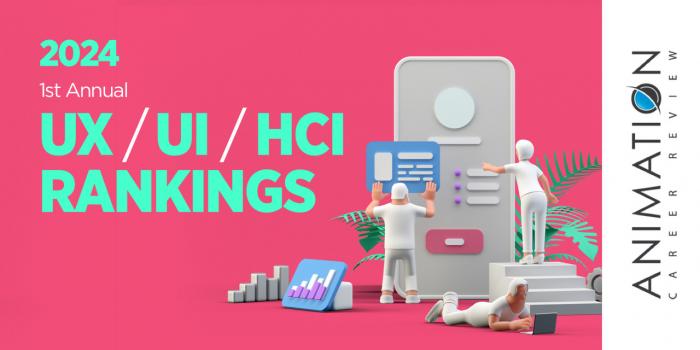
Learn the cutting-edge skills to design engaging user experiences with an online Bachelor of Arts (BA) in Graphic Design with a concentration in User Experience Design at Southern New Hampshire University. Apply today!

| Ranking | School | State |
|---|---|---|
| 1 | Carnegie Mellon University | Pennsylvania |
| 2 | Drexel University | Pennsylvania |
| 3 | Cornell University | New York |
| 4 | University of Maryland | Maryland |
| 5 | Pennsylvania State University | Pennsylvania |
Our 2024 rankings of the Top 5 undergraduate UX/UI/HCI school programs on the East Coast. For an explanation of ranking criteria, click here.

Carnegie Mellon University (CMU) is one of the world’s first universities to offer a major in Human-Computer Interaction (HCI). Launched in 2020 and housed in the School of Computer Sciences (SCS), Human–Computer Interaction Institute (HCII), CMU’s HCI program has BS, minor, and concentration options. The BS requires 35 courses, the interdisciplinary minor consists of three courses and nine-plus elective units, and the concentration comprises five courses including two required courses and three elective courses.
Students enrolled in any Carnegie Mellon undergraduate program may enroll in the school’s Interdisciplinary HCI Major. This option allows students to maintain their primary major and complete the Interdisciplinary HCI major by taking 12 prerequisite and required courses. Course examples include Programming Usable Interfaces (PUI); Design Educational Games; Software Structures for User Interfaces (SSUI); Statistics for Lab Sciences; and User-Centered Research & Evaluation (UCRE).
The HCI BS program at Carnegie Mellon University consists of coursework in humanities and the arts, math, statistics, science and engineering, psychology, ideation and design, computing, and research and evaluation. Course examples include Digital Service Innovation; Matrices and Linear Transformations; Statistical Graphics and Visualization; Reason, Passion and Cognition; Advanced Interaction Design; and Software Structures for User Interfaces.
In addition to required courses, BS students have the opportunity to take up to four elective courses in the areas of design and technology. Design of Artificial Intelligence (AI) Products and Services; Human AI Interaction; Computer Game Programming; Digital Service Innovation; Gadgets, Sensors and Activity Recognition in HCI; and Human Robot Interaction.
Throughout the program, BS students will have opportunities to design for digital technologies such as virtual and augmented reality (VR/AR), web, fabrication, mobile, IoT, and gadgets. The program culminates with a Capstone course, which consists of a team project that allows students to work with CMU-based clients or external clients to design, build, and test a software applications. Second HCI major students will also complete the Capstone.
The HCI minor at Carnegie Mellon University is open to students in computer science, information systems, and mechanical engineering as well as areas such as art, design, psychology, statistics, architecture, and decision science, and business administration. The HCI concentration is designed for SCS students. Across options, area explored include digital technologies, virtual and mixed reality (VR/MR), and human psychology as it relates to interactions with digital services and products.
Students in the HCI minor and concentration have access to many of the same courses as students in the BS program do. Students in both options will take Designing Human-Centered Software (DHCS) and Interaction Design Fundamentals. Elective examples include Building User-Focused Sensing Systems; Artificial Intelligence Methods for Social Good; Machine Learning in Practice; Experimental Animation; and Web Application Development.
Graduates of the HCI minor are prepared to pursue careers related to the creation of new interactive products, environments, services, and systems. Graduates of the HCI BS program, second major, and concentration at Carnegie Mellon University are well-positioned to compete for careers in the tech industry. Examples include Interaction Designer, Technical Product Manager, UX Engineer, and Front End Engineer. Some program alumni go on to pursue graduate study at CMU or other major universities.
Founded on November 15, 1900 by industrialist and philanthropist Andrew Carnegie, Carnegie Mellon University opened its doors as Carnegie Technical Schools. Today, this private global research university provides more than 200 programs to approximately 16,780 students representing 126 countries. In addition to the main campus in Pennsylvania, CMU has campuses in California's Silicon Valley and Doha, Qatar.
Housed across seven colleges and schools, Carnegie’s academic programs are also provided in Africa, Asia, Australia, Europe, Mexico, and Portugal. Carnegie Mellon University is accredited by the Middle States Commission on Higher Education (MSCHE).

Drexel University houses the Antoinette Westphal College of Media Arts & Design, home to the undergraduate User Experience & Interaction Design (UXID) program. As part of the Westphal College, students in this program benefit from a studio-based curriculum; access to computer labs, a hybrid making lab and shop facilities, and the materials library; and opportunities to collaborate with other art and design students on projects within the college’s in-house record label, graphic design firm, and lifestyle magazine.
All students will participate in the Drexel University Co-op Program, which provides the opportunity to work with a variety of companies and studios. Co-ops are six months, full-time. Examples of places students have worked include Franklin Institute Science Museum, Dream Machine Creative, Night Kitchen, YouTube, Toll Brothers, Sedso Design, Matte Finish, The Glimpse Group, and Philadelphia Theatre Company, Janell Wysock Textile Designs, and History Making Productions.
Leading to a BS, the UXID program explores five major areas: User Experience Design; User Interface and Interaction Design; Development; Information Architecture (IA) and Content Strategy; and Project Management. During the first two years of the program, students will learn how to design and code. The junior and senior years consist of elective coursework and working with interdisciplinary teams on projects.
The UXID BS program at Drexel University culminates with the Senior Capstone Project, which results in a full-blown, professional product launch. In addition, students will graduate with polished portfolio of their best work. Some program alumni have been hired by co-op companies, many have launched their own start-ups, and others have gone on to pursue graduate studies at Drexel and other top universities.
Drexel University was established in 1891 as Drexel Institute of Art, Science, & Industry. The school serves approximately 22,345 students enrolled in more than 200 degree programs across 15 colleges and schools. Drexel University is accredited by the Middle States Commission on Higher Education (MSCHE). The school’s academic programs in art, design and media are accredited by the National Association of Schools of Art & Design (NASAD).

Information Science at Cornell University is listed as a major in the College of Arts and Sciences; the Ann S. Bowers College of Computing and Information Science (Cornell Bowers CIS); and the College of Agriculture and Life Sciences (CALS). At the undergraduate level, depending on the college, students can earn a BA or a BS. Students may also choose a concentration. Just a few examples include UX Design; Interactive Technologies; and Networks, Crowds, and Markets.
The Information Science BA/BS with a concentration in UX Design emphasizes hands-on learning and coursework in four areas including Core Principles of Design; Design in Context; Knowing the User; and Knowing the Technology. Across areas, course examples include Qualitative User Research and Design Methods; Human-Computer Interaction Design; Intelligent User Interfaces; Crowds, Communities, and Technology; Communication in Virtual Worlds; Human Computer Interaction Studio; Interactive Information Visualization; Novel Interaction Techniques; Teams and Technology; Human-AI Interaction Design Research; App Design and Prototyping; and Re-Designing Robots.
In addition to immersive courses, Information Science-UX Design students will have opportunities to complete a number of projects, an internship, and a study abroad experience. Internships and participation in the Cornell University study abroad program are optional.
Upon completion of the UX Design program at Cornell, students will have a professional portfolio of their best work. Graduates are prepared to pursue job titles such as User Experience Designer, User Experience Architect, Product Designer, Usability Analyst, Interaction Designer, Technical Product Manager, and User Research Associate.
Examples of companies that have hired Cornell University Information Science alumni include Amazon, Microsoft, Capital One, Google, Deloitte Consulting, Apple, Meta, Visa, Bank of America, Procter & Gamble, American Express, L’Oreal USA, and Accenture.
Cornell University was founded in 1865 by Ezra Cornell and Andrew Dickson White. In 1868, Morrill Hall, the first building constructed on campus, opened its doors to 412 male students. Today, the Cornell campus consists of 608 buildings situated on more than 2,000 acres. The school also has campuses across the State of New York, and in DC, Doha, Qatar, and Rome, Italy.
Cornell University employs 10,830 educators and staff that serve approximately 25,900 male and female students enrolled in more than 300 majors, minors, and graduate programs across 16 colleges and schools. Cornell University has been continuously accredited by the Middle States Commission on Higher Education (MSCHE) since 1921.

The College of Information Studies at University of Maryland (UMD) houses an undergraduate Technology and Information Design (InfoDesign) program that leads to a BA. As part of the UMD INFO College (or iSchool), the BA program provides opportunities to connect with one of more than 400 top industry partners through the INFO Corporate Partnership Program. Employers, corporations, and organizations engage with students through hands-on capstone projects, campus events, and UMD’s Careers Listserv.
The UMD INFO College also provides hands-on learning opportunities at the school’s research centers and labs. Examples include the Human-Computer Interaction Lab (HCIL); the Center for Archival Futures (CAFe); the Values-Centered Artificial Intelligence (VCAI) Initiative; and the Computational Linguistics and Information Processing (CLIP) Lab.
Technology and InfoDesign BA at UMD requires 120 credit hours. This includes a combination of general education, major, and elective courses. Sample courses include AI and Society; Designing Fair Systems; Modeling and Simulating Systemic Problems; Cross-disciplinary Design Communication Lab; and Prototyping and Development Technologies Studio. Examples of major electives include Information User Needs and Assessment; Video Games as Emergent Experiences; Designing Patient-Centered Technology; Information Organization; and Game Design Studio.
The culminating experience for the Technology and InfoDesign BA at University of Maryland is the Integrated Capstone for Technology and Information Design course. This semester-long course consists of working in teams on a project for a real-world client. This includes identifying client problems and designing solutions. Based on what they’ve learned during the course of the BA program, students will build design proposals; direct system and user analyses; and review project achievements and defeats.
Graduates of the UMD INFO College are prepared to pursue a variety of roles at companies and organizations across industries. College alumni have gone on to reconstruct the New York Times UX; address Chicago’s information infrastructure; govern the American Library Association (ALA); and oversee social media for the United Nations. UMD iSchool alumni also work for Google, Booz Allen Hamilton, Facebook, National Geographic, Capital One, Walmart, AT&T, the National Standards Bureau (NIST), and VIDAA.
Founded in 1856, University of Maryland is the flagship institution of the State of Maryland. The school employs more than 14,000 faculty and staff members that serve approximately 40,710 students. UMD provides more than 300 academic programs across 12 colleges. University of Maryland is accredited by the Middle States Commission on Higher Education (MSCHE).

Pennsylvania State University (Penn State) is home to the world’s largest student-run philanthropy; more than 50,000 career preparedness programs; one of the nation’s largest athletic programs; and 20 expansive undergraduate campuses across the state. The school’s main campus (University Park) houses the College of Information Sciences and Technology (IST), which provides more than 30 on-campus and online programs at all degree levels.
At the undergraduate level, the College of IST at Penn State has a Human Centered Design and Development (HCDD) program that leads to a BS. The program emphasizes three areas: designing and building practical technologies to meet the demands of a constantly evolving world; pinpointing opportunities to augment experiences through the use of technology; and identifying ways in which technology can bolster human activity. Students will utilize quantitative and qualitative techniques within this third area.
Within the HCDD BS program are eight application focus areas. Students may also customize their own focus area. Formal options include Digital Arts and Communication; Healthcare; Geographic Information Systems; Data Sciences; Psychology; Security and Risk; Informatics; and Sociology.
To further enhance the HCDD BS program, the College of IST provides minor options such as Digital Media Trends and Analytics; IST for Communication Arts and Sciences; and Entrepreneurship and Innovation. In addition, students are required to complete at least one HCDD internship to gain valuable experience before graduation. Past internships have consisted of activities such as researching and testing application usability; website consulting; integrating virtual reality in to curriculums; modernizing airport terminals via mobile and web developments; and creating mobile-friendly websites.
Graduates of the BS program at Pennsylvania State University are prepared for a variety of HCDD-related careers across industries. Recent graduates have accepted roles such as User Interface Developer, UX/UI Researcher, Web Application Develop, Product Designer, Usability Engineer, Mobile Application Developer, Information Architect, Instructional Designer, and Systems Analyst.
Pennsylvania State University (Penn State or Penn) is one of only three land- space- sun-, and sea-grant universities in the U.S. Chartered in 1855, the Penn serves approximately 88,115 students from all 50 states and 145 countries. More than 275 undergraduate majors and 300+ graduate and professional programs, are provided across 24 campuses, sixteen academic colleges, and several schools. Pennsylvania State University has been accredited by the Middle States Commission on Higher Education (MSCHE) since 1921.